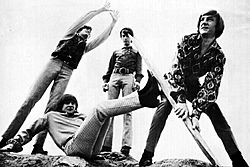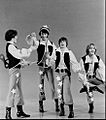The Monkees facts for kids
Quick facts for kids
The Monkees
|
|
|---|---|

The Monkees in 1967
|
|
| Background information | |
| Origin | Los Angeles, California, United States |
| Genres | Pop rock, bubblegum pop, psychedelic pop |
| Years active | 1966–1970 1986–1989 1993–1997 2001–2002 2010–2012 |
| Labels | Colgems, RCA, Bell Records, Arista |
| Members | Micky Dolenz |
| Past members | Davy Jones (deceased) Peter Tork (deceased) Michael Nesmith (deceased) |
The Monkees was a famous American pop-rock band. They were first created for a Comedy TV show called The Monkees. This show aired on NBC from 1966 to 1968. The band had four members: Davy Jones, Michael Nesmith, Peter Tork, and Micky Dolenz.
The Monkees had many hit songs. Some of their most popular ones include "Last Train to Clarksville," "I'm a Believer," and "Daydream Believer." Talented songwriters and producers like Tommy Boyce, Bobby Hart, and Chip Douglas helped them create their music. Many of their songs came from writers at the Brill Building in New York City.
Contents
Meet The Monkees: Band Members
Out of 437 people who tried out for the TV show, four actors with musical skills were chosen. Each member had a unique personality and could entertain an audience. They could also sing well.
Davy Jones
British actor Davy Jones already had a contract with Columbia Pictures. He had released records and performed on TV in both Britain and America. Columbia wanted a project for Jones. Screen Gems, which was Columbia's TV part, produced the show.
Michael Nesmith
Nesmith was from Texas. He played in country and rock bands. He had also published his own songs.
Micky Dolenz
Dolenz was a former child actor from Los Angeles, California. He sang and played in cover bands.
Peter Tork
Tork worked as a folk musician in New York's Greenwich Village.
How The Monkees Started
Bob Rafelson and Bert Schneider wanted to make movies. However, they didn't have much experience yet. Schneider's father was the president of Columbia Pictures. He gave them a chance to make a pilot episode for a TV series. If a TV network bought the series, they could gain film experience by producing and directing episodes.
Rafelson had always wanted to create something about the lives of musicians. He was inspired by The Beatles' movies, A Hard Day's Night and Help!. Rafelson and Schneider changed the idea a little. They kept the slapstick comedy from the Beatles' movies. But they showed The Monkees as an unknown band trying to become famous.
Learning to Act and Play
Actor James Frawley worked with Rafelson and Schneider. He also worked with the Monkees after they were chosen. Before filming began, Frawley spent six weeks with the band members. He taught them about improvisation in acting and comedy. He also helped them learn to play their characters.
The pilot episode was filmed in the fall of 1965. When it was first shown to a test audience, they didn't like it much. The episode was changed, and then test audiences loved it. Because of this, NBC bought the series. To make sure there was enough music for the show, music publisher Don Kirshner was hired. His songwriters from the Brill Building were some of the best young talents at that time.
The Monkees TV Show
The Monkees TV show aired for two seasons on NBC. A total of 58 episodes were made. The show won two Emmy Awards in 1967. This helped bring attention to the Monkees' records. The show was written for children and teenagers. However, it also had jokes and other things that older viewers could enjoy.
Unique Show Style
The band sometimes talked directly to the audience. They even made fun of the fact that they were on a TV show. Many episodes ended with short interviews with the Monkees. In these interviews, they talked about their careers and things important to them. This made their fans feel like they knew the band members.
Each episode featured two songs. The first was usually a song fans already knew. The second was a new song. The band lip-synched to recordings on camera. They also filmed unrelated scenes in random places with different objects. These scenes were put together and called "romps." The romps looked a lot like music videos.
The Monkees' Music Journey
People started saying that none of the Monkees could play a musical instrument. This was because the band had little practice playing together. So, they couldn't make the music needed for the show at first. Because of this, studio musicians mostly played the music on their first records.
Learning and Playing Instruments
Nesmith and Dolenz played guitar. Dolenz took drum lessons so he could play drums on camera. Tork played guitar, keyboards, and banjo. Jones learned to play drums and guitar. A special bass guitar was even made just for him. He also played percussion instruments, like the tambourine.
Over time, the band got better at playing music. They wanted a chance to play on their own recordings. They also started performing live for audiences. Kirshner didn't want them to do that. He even released an entire album without telling the band. He also planned to release a new single.
Taking Control of Their Music
After Kirshner released the single "A Little Bit Me, A Little Bit You" (written by Neil Diamond) without the band's permission, he was fired. To prove themselves, the Monkees recorded a new single and then a new album. Each member played an instrument on these new recordings. Their new records didn't sell as well as their first ones. But they felt better knowing the music was truly theirs. They still had hit records, too.
The End of the TV Show
The Monkees grew tired of the same story pattern in every episode. (Davy Jones would fall in love with a girl, and the band would help him.) They wanted to try doing a variety show instead. However, NBC and the show's producers didn't want to change the show's format. The two sides couldn't agree. So, the show was cancelled, even though it was still very popular.
After the TV series ended, the Monkees tried making a movie and a TV special. But neither was very successful. They kept performing for audiences, but fewer and fewer people came to their shows. The band members started to leave one by one. Tork left at the end of 1968, saying he was tired. Nesmith left in 1970 to start his own band. Jones left in 1970 and went back to performing alone.
The Monkees TV show appeared in reruns on CBS from 1969 to 1972. It played during lunchtimes and later alongside Saturday morning cartoons. ABC later aired the series from 1972 to 1973.
The Monkees in the 1970s and Beyond
Each former Monkee tried different things in the years after the show.
- Tork worked as a musician, teacher, and singing waiter.
- Nesmith pursued a country music career. He later started making videos.
- Dolenz sang on records and did cartoon voice-overs.
- Jones sang on records and did more theater work. He teamed up with Dolenz in 1976 to tour and perform the Monkees' old hits. They also went to England.
The Monkees episodes appeared on other TV stations that paid to play them from 1975 onward. They usually played on local TV stations during afternoons. A compilation album, The Monkees Greatest Hits, was released. Their old hits were still played on radio stations. A second Greatest Hits album came out later.
Reunions and New Fans
In 1986, Tork, Jones, and Dolenz reunited for an "oldies show" tour. Nesmith made a few rare appearances. He couldn't fully join the tour because of his work as a producer. MTV aired almost every episode of their old series one Sunday to promote the tour. It became a huge surprise hit! Twenty years after they started, The Monkees had a new generation of fans. The tour grew from a small one to a major one, and The Monkees were back. Nickelodeon, a channel related to MTV, also aired their series.
During the 1990s, the reunited Monkees continued to tour and appear as guests on TV. Nesmith rejoined them for a new album, Justus, and a TV special. He also appeared with them onstage in England. However, he left when they started touring the United States and didn't return. After 2000, they toured less often. Tork left again in 2001, and Jones and Dolenz stayed together until 2002.
Every episode of the TV series is available on DVD. Their movie Head is also available. All their record releases can be found on compact disc and streaming services like Spotify, Apple Music, and Amazon Music. Rhino Records bought the rights to all their works and still manages Monkees releases.
Dolenz, Tork, and Jones toured again in the UK and USA throughout 2011.
Remembering The Monkees
Davy Jones passed away on February 29, 2012, in Stuart, Florida. Peter Tork died on February 21, 2019, in Connecticut. He had battled a rare cancer for 10 years. Michael Nesmith died from heart failure at his home in Carmel Valley, California, on December 10, 2021, at age 78.
Fun Facts About The Monkees
- Only Peter Tork and Micky Dolenz appeared in every episode of the TV show. Davy missed one show for his sister's wedding. Nesmith only missed three shows.
- Micky and Michael both tried out to play the Fonz on Happy Days. But they were considered too tall for the part. Henry Winkler was chosen instead.
- Michael Nesmith's mom, Bette Nesmith Graham, invented correction fluid. She first called it "Mistake Out," but it was renamed "Liquid Paper."
- Musician David Bowie used to go by Davy Jones. When The Monkees became popular, he changed his name to David Bowie. This was so he wouldn't be confused with the Monkees star. He chose the name after Jim Bowie and his famous knife.
- Davy Jones's nickname was "Frito."
- Peter Tork's full name was Peter H. Thorkelson.
- In 1967, The Monkees' albums sold more than The Beatles and The Rolling Stones combined!
- Between season 1 and season 2, Davy Jones fasted for three weeks. He wanted to lose enough weight to be considered unfit for duty in the Army.
- Because they were hired as actors and not originally as musicians, they have been banned from the Rock and Roll Hall of Fame.
Discography
- The Monkees (1966)
- More of The Monkees (1967)
- Headquarters (1967)
- Pisces, Aquarius, Capricorn & Jones Ltd. (1967)
- The Birds, The Bees & the Monkees (1968)
- Head (1968)
- Instant Replay (1969)
- The Monkees Present (1969)
- Changes (1970)
- Pool It! (1987)
- Justus (1996)
- Good Times! (2016)
- Christmas Party (2018)
Images for kids
-
Davy Jones and Peter Tork in 1966
See also
 In Spanish: The Monkees para niños
In Spanish: The Monkees para niños







